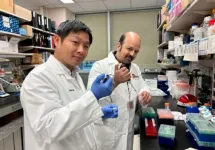Scientists at St. Jude Children’s Research Hospital discovered a new compound that selectively targets parts of a cancer-related protein, EP300/CBP, in Group 3 medulloblastoma.
(MEMPHIS, Tenn. – April 25, 2024) Medulloblastoma (the most common malignant childhood brain tumor) is separated into four molecular groups, with Group 3 bearing the worst prognosis. By studying EP300 and CBP, critical proteins in Group 3 medulloblastoma cells, scientists at St. Jude Children’s Research Hospital designed a way to enhance anti-tumor activity by targeting a specific part of these proteins. This targeted approach significantly reduced cancer cell growth. The findings were reported today in Nature Communications.
Previous research by St. Jude scientists and others has classified medulloblastoma into four distinct molecular groups: WNT and SHH — driven by their namesake genetic mutations — Group 3 and Group 4. The prognosis for medulloblastoma is different for each molecular group. Retrospective analyses have shown that WNT tumors have 95% five-year survival. SHH and Group 4 tumors have approximately 75% five-year survival, and the survival rate for Group 3 is only 60%. Approximately one-third of all patients with medulloblastoma relapse, but the rate of relapse varies based on factors such as the patient’s age and what type of therapy they receive.
Scientists often pharmaceutically target specific domains, or regions, of tumor proteins to inhibit cancer cell growth. EP300 and CBP are highly similar proteins that drive cancer cell growth and, therefore, tumor progression, making them attractive targets for therapy.
“EP300/CBP have different domains that have small molecules that bind to them and can disrupt their function,” said Adam Durbin, MD, PhD, Department of Oncology. “We wanted to understand if targeting these proteins in specific ways would be more effective. We saw that disrupting individual domains was not equal in how it affects cancer cells.”
Targeting two different parts of the same proteins
The researchers identified inhibitors that can interact with either of two specific regions of EP300/CBP: the histone acetyltransferase (HAT) domain and the bromodomain. Using high-throughput cell line–based screening, the team tested these region-specific inhibitors across over 400 different cancer cell lines. They found that bromodomain inhibition with a compound called inobrodib was more effective at killing Group 3 medulloblastoma cells than targeting the HAT domain.
“The effects of bromodomain targeting of EP300/CBP are profound, causing the inactivation of a network of genes that Group 3 medulloblastoma cells critically require to survive,” said first author Noha Shendy, PhD, St. Jude Department of Oncology.
Think of the HAT and the bromodomain regions of EP300/CBP as two light switches in a room, controlling different lights — one for overhead and one for a lamp. Now, consider drugs as being able to toggle these switches on and off. Turning off the overhead light is different than turning off the lamp, but each causes the room to be dimmer. Similarly, when drugs bind to the two regions of EP300/CBP, they modify the activity of these regions, influencing the “brightness” of different cellular processes regulated by these proteins.
The researchers found that using inobrodib to disrupt the activity of the bromodomain region in Group 3 medulloblastoma cells was especially effective at slowing tumor cell growth. Bromodomain inhibition decreased the “brightness,” thereby inactivating Group 3 medulloblastoma tumor-promoting genes and offering a potential therapeutic benefit.
“We found a new target that is druggable in this aggressive pediatric brain tumor that we’re continuing to study to try to help patients,” noted Durbin.
Enhancing drug efficacy for targeted treatment in medulloblastoma
While inobrodib is already in clinical trials and is being used to treat patients with multiple myeloma and relapsed acute myeloid leukemia, it cannot be used as it is to treat medulloblastoma. That is because inobrodib had difficulty crossing the blood-brain barrier — a needed quality for any intravenous or oral drug-based brain tumor therapy.
Based on their promising results with inobrodib, the researchers set out to create a new, modified drug capable of reaching the brain. With collaborators Martine Roussel, PhD, St. Jude Department of Tumor Cell Biology, and co-corresponding authors Jun Qi, PhD, Dana-Farber Cancer Institute, and Ernst Schonbrunn, PhD, Moffitt Cancer Center, the team created a novel version of the drug that improved selectivity and efficacy in targeting EP300/CBP, including in Group 3 medulloblastoma cells.
“When we treat the cells in cell culture with the bromodomain inhibitor, we caused this profound change in expression of a whole network of genes that are required for these cells to remain alive,” Durbin said. “Bromodomain inhibition impacted genes that are uniquely required in medulloblastoma cells, but targeting the HAT domain has far fewer effects.”
Another advantage of targeting the bromodomain is that it may cause less toxicity than current drugs due to its greater specificity. “We’re targeting the same protein, but only a specific domain,” Durbin said. “That’s particularly important because, hopefully, it will let us use much lower doses of those compounds, and, hopefully, that will lead to them being much better tolerated.”
These findings suggest that inhibiting specific EP300/CBP protein regions should be pursued further for treatment of Group 3 medulloblastoma and possibly other cancers.
Authors and funding
The study’s other co-first authors are Melissa Bikowitz, of Moffitt Cancer Center and Morsani College of Medicine; and Logan Sigua of Dana-Farber Cancer Institute. Additional authors of the study are Matthew Rees, Melissa Ronan, Mustafa Kocak and Jennifer Roth of the Broad Institute of MIT and Harvard; Qi Liu and Tingjian Wang of Dana-Farber Cancer Institute; Yang Zhang, Audrey Mercier, Yousef Khashana, Stephanie Nance, Ian Delahunty, Sarah Robinson, Vanshita Goel, Yingzhe Wang, Burgess Freeman, Brent Orr, and Brian Abraham of St. Jude.
The study was supported by grants from the National Institutes of Health (K08-CA245251, P30-CA021765, P30-CA076292 and P01-CA-96832), Alex’s Lemonade Stand Foundation, CureSearch for Children’s Cancer, the V Foundation for Cancer Research and the Hyundai Hope on Wheels Foundation, the Rally Foundation for Childhood Cancer Research and ALSAC, the fundraising and awareness organization of St. Jude.
If you are interested in licensing the EP300 and CBP Binding Compounds from St. Jude (SJ-23-0032) for further development and/or commercial use, find out more about licensing.
St. Jude Media Relations Contacts
Chelsea Bryant
Desk: (901) 595-0564
Cell: (256) 244-2048
chelsea.bryant@stjude.org
media@stjude.org
Rae Lyn Hartley
Manager, Media Relations
Desk: 901-595-4419
Cell: 901-686-2597
raelyn.rushing@stjude.org
St. Jude Children's Research Hospital
St. Jude Children's Research Hospital is leading the way the world understands, treats and cures childhood cancer, sickle cell disease and other life-threatening disorders. It is the only National Cancer Institute-designated Comprehensive Cancer Center devoted solely to children. Treatments developed at St. Jude have helped push the overall childhood cancer survival rate from 20% to 80% since the hospital opened more than 60 years ago. St. Jude shares the breakthroughs it makes to help doctors and researchers at local hospitals and cancer centers around the world improve the quality of treatment and care for even more children. To learn more, visit stjude.org, read St. Jude Progress, a digital magazine, and follow St. Jude on social media at @stjuderesearch.
END





